Homo sapiens › Roman Mosaics » Ancient origins
Articles and Definitions › Contents
- Homo sapiens › Ancient History
- Roman Mosaics › Antique Origins
Ancient civilizations › Historical and archaeological sites
Homo sapiens › Ancient History
Definition and Origins
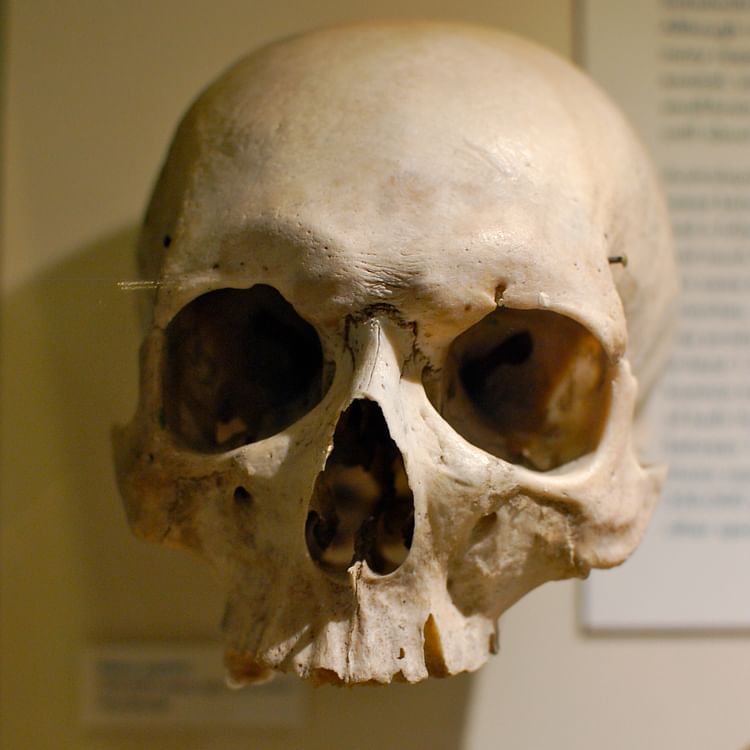
Homo sapiens ('wise man'), or modern humans, are the only species of human still around today. Despite having invented countless ways of labelling the world around us, we have so far done a surprisingly poor job at defining ourselves. Originating in Africa somewhere around 200,000 years ago, and adventuring beyond that initial continent from at least 55,000 years ago, with our characteristically slender skeletons and big heads, one would think the story is quite clear cut.
However, there is more than one way to define a species - for instance, not just biologically but also based on morphological features or on DNA - and modern humans are still evolving and changing. Our brain size, for instance, has actually shrunk over the past 20,000 years (some people's a bit more than others). Genetically, we are not a 100% Homo sapiens only: non-African humans have on average around 2% Neanderthal DNA, and we are also known to have interbred with at least one other, now-extinct human species: the Denisovans. Modern humans spread across the far reaches of the globe, and developed technologies and culture eventually showing symbolic thought by at least 40,000 years ago. From a long existence as hunter-gatherers, the eventual switch to agriculture helped shape the world as we know it today with towns, cities, and an increasingly large population that is now threatening to burst out of the planet's seams.
So, since the story is not exactly simple, any definition will have to stretch beyond just a few sentences, too.
THE ORIGINS OF OUR SPECIES
The place where modern humans developed from their ancestors to the point where they became recognisably modern human was for a long time a source of fierce bickering and arguing. Initially, Africa was ignored due to a lack of fossil evidence (which made it look like an archaeological backwater) in favour of models that favoured other locations of origin, pointed at a development in multiple regions simultaneously, or postulated that modern humans evolved from Neanderthals (which is not the case).
IT HAS BECOME CLEAR THAT AFRICA IS ACTUALLY THE PLACE THAT HOUSES OUR COMMON ORIGIN.
However, thanks to new archaeological discoveries over the last few decades, better dating, and genetic evidence, it has become clear that Africa is actually the place that houses our common origin. The dominant view today is that archaic humans – usually thought to be Homo heidelbergensis, who in itself developed from Homo erectus - gradually evolved into Homo sapiens by approximately 200,000 years ago, in either Eastern- or Southern Africa. The first signs of the modern human benchmark of a high, round skull appears at Omo Kibish (Omo 1) in Ethiopia around 195,000 years ago. Within Africa itself, we were not an isolated species; some degree of mixture with archaic species took place, but the details of this are not yet clear.
The first known brave Homo sapiens souls who ventured out beyond Africa are found at the sites of Skhul and Qafzeh in Israel, where burials have been dated to be older than 100,000 years ago – and perhaps even up to a staggering 130,000 years ago. However, the main wave(s) of modern humans who left Africa decided they needed a bit more preparation time for the wide world beyond, and waited until around 55,000 years ago. This time, larger numbers spread to way further reaches than ever before. Eastern Eurasia was reached by at least 40,000 years ago; Australia between 53,000-41,000 years ago (although it now looks like another, possibly earlier group of humans from an earlier migration already reached the north of Australia by 65,000 years ago) ; Europe – the last stronghold of the Neanderthals - was not braved until around 45,000 years ago; and the Americas took longer still, until around 15,000-14,000 years ago.

Stringer Graph-model of Homo Evolution
Along our trip around the world (not in 80 days, I imagine), Homo sapiens encountered other human species who had beaten them to certain regions and put their stamp on it. Interestingly, some of these, certainly at least the Neanderthals and Denisovans, also put their stamp on us: we interbred with them, and their DNA is still visible in non-African DNA today.Interestingly, this was not our first connection with these two species, as we share a common ancestor with them around 500,000-600,000 years ago, too. So, all in all, our evolution was obviously not a single, straight line, but rather like a frustratingly difficult puzzle.
THE BARE BONES
Despite variations both when it comes to different points in time as well as differences between various corners of the planet, human skeletons have a basic set of features in common that set us apart from other species. Even early members of our species had a more slender and gracile skeleton than our more robust predecessors, which when spreading out to colder regions meant we were less well able to cope with the low temperatures, as our lighter builds make it more difficult to retain heat.
Luckily, modern humans are also characterised by having very large brains (on average 1300 cubic centimetres), housed in a higher and rounder braincase – giving us high, vertical foreheads - than sported by other human species. This undoubtedly helped us in both using fire to our advantage and in developing pretty useful clothing to keep us warm when dealing with less instantly pleasant temperatures.
After the first clear characteristics tying in with this skull shape began to appear around 200,000 years ago, in Africa, already by 150,000 years ago had early modern skulls undergone a basic reshaping of the skull form to fit with the modern pattern.Another point of contrast with other early humans is that we have almost none of the heavy brow ridges they show; we have a well-defined chin and our faces are tucked in under our braincases rather than protruding forward.
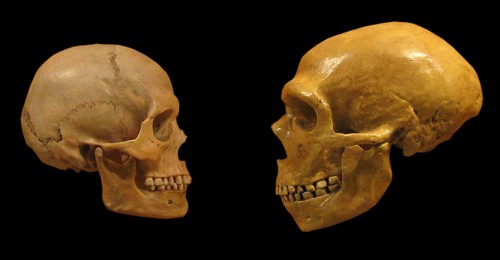
Homo Sapiens & Neanderthal Skulls
LIFESTYLE
Modern humans started off as hunter-gatherers, foraging and killing what they needed to survive and, when needed, moving around in pursuit of available food resources. From around 9000 years ago onward, the Neolithic saw the beginning of farming, which changed the whole dynamic of societies to a more sedentary lifestyle, with permanent residences popping up all over the place.
The use and development of tools – increasingly complicated ones – was and is essential to Homo sapiens' survival, right from our beginnings onwards. From retouched flake tools in the Middle Palaeolithic industry to the sophisticated bone, antler and ivory tools - including sewing needles and spear throwers - of the Late Palaeolithic through to agricultural tools with the transition to agriculture from around 9000 years ago, modern humans became ever more adaptable and versatile. Of course, one could argue that although we can now create complex tools such as the smartphone, we have become so glued to these screens this may come with certain side-effects.
THE USE & DEVELOPMENT OF TOOLS – INCREASINGLY COMPLICATED ONES – WAS & IS ESSENTIAL TO HOMO SAPIENS' SURVIVAL.
Homo sapiens, moreover, developed from initially living mostly in natural shelters such as caves, to constructing their own huts from wood or even mammoth bones, and eventually forming settlements and cities from a whole range of materials.Modern humans would never have reached this point if not for fire, though, the more habitual use of which has been around since at least 400,000 years ago (by our ancestors). Language must be mentioned, too, because although we can barely keep our mouths shut nowadays it obviously did not start out that way. It must have developed somewhere during our hunter-gatherer existence, but the exact point proves very elusive indeed.
Art has been around for ages, too, with the most definitive and widespread evidence for actual symbolic art stemming from Europe by at least 40,000 years ago, with its magnificently painted caves such as Chauvet Cave and Lascaux Cave.

Panel of the Rhinos, Chauvet Cave (Replica)
THE QUESTION OF MODERNITY
This artistry forms part of the suite of modern features us modern humans tend to feel sets us apart from the rest of the world around us. But at which point in our evolutionary history did we become behaviourally modern humans, and what exactly does this entail?
Although a universally accepted definition is seemingly too much for our behaviourally modern brains to come up with, a key component seems to lie in our ability to communicate within a symbolically organised world and in using symbols in different social and economic contexts.
The 'when' question is as of yet harder to answer. This behaviour obviously did not simply pop up overnight, in groups all across the Old World, as if a universal switch had been flicked. Modernity consists of many different features that appeared gradually throughout time and space. Symbolic burials rear their heads as early as c. 115,000 years ago (Skhul Cave, Israel), with red ochre perhaps being used symbolically not long after. By 60,000 years ago most of the aspects we associate with modernity had appeared, in varying packages, among which complex tools; evidence for rituals; and complex treatment of the dead. By at least 40,000 years ago, fully modern behaviour - including figurative art; ritualistic or mythical imagery and signalling; and artefacts such as musical instruments – is visible throughout the Old World.
It used to be hip to attribute any kind of possibly symbolic prehistoric behaviour exclusively to Homo sapiens, rather than for instance the Neanderthals, who were around until c. 30,000 years ago. However, it is clear that they, too, showed at least certain aspects of modernity, and we have no way of knowing whether the Neanderthals would have eventually developed into MacBook-hugging techies or not. Homo sapiens holds the monopoly because after c. 30,000 years ago, we were the only humans left – albeit carrying small portions of DNA from other humans with us.
Roman Mosaics › Antique Origins
Ancient Civilizations
Roman mosaics were a common feature of private homes and public buildings across the empire from Africa to Antioch. Not only are mosaics beautiful works of art in themselves but they are also an invaluable record of such everyday items as clothes, food, tools, weapons, flora and fauna. They also reveal much about Roman activities like gladiator contests, sports, agriculture, hunting and sometimes they even capture the Romans themselves in detailed and realistic portraits.
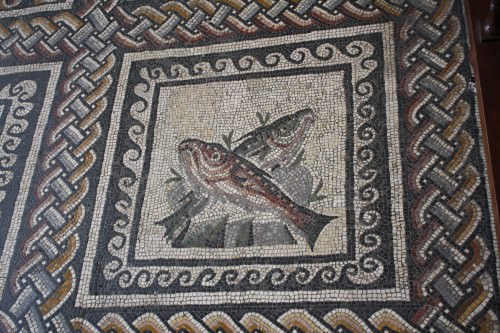
Roman Mosaic
TECHNIQUE
Mosaics, otherwise known as opus tesellatum, were made with small black, white and coloured squares typically measuring between 0.5 and 1.5 cm but fine details were often rendered using even smaller pieces as little as 1mm in size. These squares ( tesserae or tessellae ) were cut from materials such as marble, tile, glass, smalto (glass paste), pottery, stone and even shells. A base was first prepared with fresh mortar and the tesserae positioned as close together as possible with any gaps then filled with liquid mortar in a process known as grouting. The whole was then cleaned and polished.
ORIGINS & INFLUENCES
Flooring set with small pebbles was used in the Bronze Age in both the Minoan civilization based on Crete and the Mycenaean civilization on mainland Greece. The same idea but reproducing patterns was used in the Near East in the 8th century BCE. In Greece the first pebble flooring which attempted designs dates to the 5th century BCE with examples at Corinth and Olynthus. These were usually in two shades with light geometric designs and simple figures on a dark background. By the end of the 4th century BCE colours were being used and many fine examples have been found at Pella in Macedonia. These mosaics were often reinforced by inlaying strips of terracotta or lead, often used to mark outlines. Indeed, it was not until Hellenistic times in the 3rd century BCE that mosaics really took off as an art form and detailed panels using tesserae rather than pebbles began to be incorporated into patterned floors. Many of these mosaics attempted to copy contemporary wall paintings.
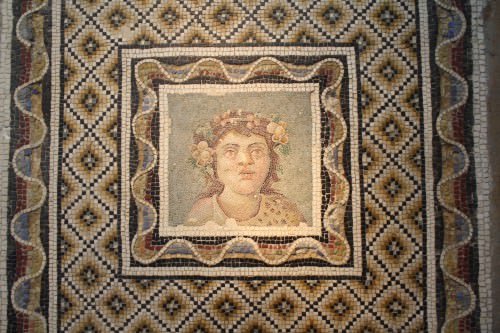
Roman Floor Mosaic
As mosaics evolved in the 2nd century BCE smaller and more precisely cut tesserae were used, sometimes as small as 4 mm or less, and designs employed a wide spectrum of colours with coloured grouting to match surrounding tesserae. This particular type of mosaic which used sophisticated colouring and shading to create an effect similar to a painting is know as opus vermiculatum and one of its greatest craftsmen was Sorus of Pergamon (150-100 BCE) whose work, especially his Drinking Doves mosaic, was much copied for centuries after. Besides Pergamon, outstanding examples of Hellenistic opus vermiculatum have been found at Alexandria and Delos in the Cyclades. Because of the labour involved in producing these pieces they were often small mosaics 40 x 40 cm laid on a marble tray or rimmed tray in a specialist workshop. These pieces were known as emblemata as they were often used as centre-pieces for pavements with more simple designs. So valuable were these works of art that they were often removed for re-use elsewhere and handed down form generation to generation within families. Several emblemata could make up a single mosaic and gradually, emblemata began to resemble more their surroundings when they are then known as panels.
EVOLUTION IN DESIGN
With a subject such as mosaics where there are difficulties of dating, tremendous variance in artistic quality, public taste and regional conventions, it is problematic to describe a strictly linear evolution of the art form. However, some major points of change and regional difference can be noted.
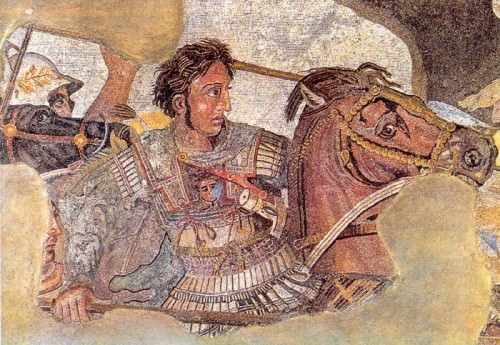
Alexander the Great
Initially, the Romans did not diverge from the fundamentals of the Hellenistic approach to mosaics and indeed they were heavily influenced in terms of subject matter - sea motifs and scenes from Greek mythology - and the artists themselves, as the many signed Roman mosaics often bear Greek names, evidencing that even in the Roman world mosaic design was still dominated by Greeks. One of the most famous is the Alexander mosaic which was a copy of a Hellenistic original painting by either Philoxenus or Aristeides of Thebes. The mosaic is from the House of the Faun, Pompeii and depicts Alexander the Great riding Bucephalus and facing Darius III on his war chariot at the Battle of Issus (333 BCE).
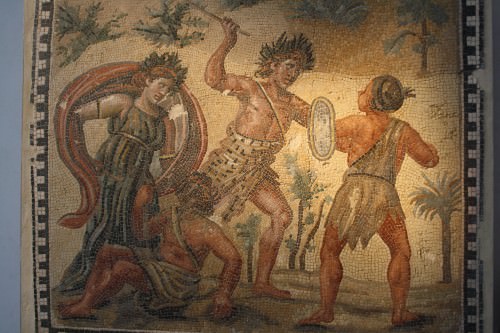
Roman Mosaic
Roman mosaics often copied earlier coloured ones, however, the Romans did develop their own styles and production schools were developed across the empire which cultivated their own particular preferences - large scale hunting scenes and attempts at perspective in the African provinces, impressionistic vegetation and a foreground observer in the mosaics of Antioch or the European preference for figure panels, for example.

Roman Mosaic
The dominant (but not exclusive) Roman style in Italy itself used only black and white tesserae, a taste which survived well into the 3rd century CE and was most often used to represent marine motifs, especially when used for Roman baths (those from the first floor of the Baths of Caracalla in Rome are an excellent example). There was also a preference for more two-dimensional representations and an emphasis on geometric designs. In c. 115 CE at the Baths of Buticosus in Ostia there is the earliest example of a human figure in mosaic and in the 2nd century CE silhouetted figures became common. Over time the mosaics became ever more realistic in their portrayal of human figures and accurate and detailed portraits become more common. Meanwhile, in the Eastern part of the empire and especially at Antioch, the 4th century CE saw the spread of mosaics which used two-dimensional and repeated motifs to create a 'carpet' effect, a style which would heavily influence later Christian churches and Jewish synagogues.
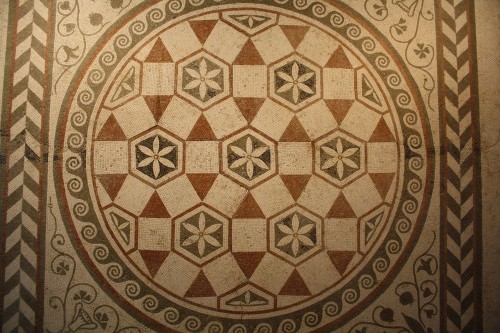
Roman Geometric Mosaic
OTHER FLOOR DESIGNS
Floors could also be laid using larger pieces to create designs on a grander scale. Opus signinum flooring used coloured mortar-aggregate (usually red) with white tesserae placed to create broad patterns or even scattered randomly. Crosses using five red tesserae and a central tesserae in black were a very common motif in Italy in the 1st century BCE and continued into the 1st century CE but more typically using only black tiles.
Opus sectile was a second type of flooring which used large coloured stone or marble slabs cut into particular shapes. Opus sectile was another technique of Hellenistic origin but the Romans also expanded the technique to wall decoration. Used in many public buildings, it was not until the 4th century CE that it became more common in private villas and, under Egyptian influence, began to use opaque glass as the primary material.
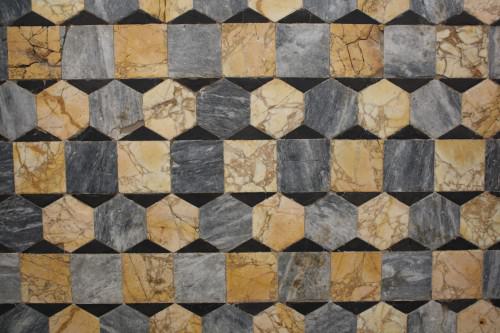
Opus Sectile Flooring
OTHER USES OF MOSAIC
Mosaics were by no means limited to flooring. Vaults, columns and fountains were often decorated with mosaic ( opus musivum ), again, especially in baths. The earliest example of this use dates to the mid-1st century BCE in the nymphaeum of the 'Villa of Cicero ' at Formiae where chips of marble, pumice and shells were used. In other locations pieces of marble and glass were also added the whole giving the effect of a natural grotto. By the 1st century CE more detailed mosaic panels were also used to embellish Nymphaea and fountains. In Pompeii and Herculanum the technique was also used to cover niches, walls and pediments and once again these murals often imitated original paintings. The walls and vaults of later Imperial Roman baths were also decorated in mosaic using glass which acted as a reflective of the sunlight hitting the pools and created a shimmering effect. The floors of the pools themselves were often set with mosaic as were the floors of mausolea, sometimes even incorporating a portrait of the deceased. Once again, the Roman use of mosaics to decorate wall space and vaults would go on to influence the interior decorators of Christian churches from the 4th century CE.
LICENSE:
Article based on information obtained from these sources:with permission from the Website Ancient History Encyclopedia
Content is available under License Creative Commons: Attribution-NonCommercial-ShareAlike 3.0 Unported. CC-BY-NC-SA License